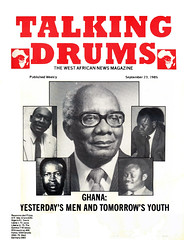Book Review
Equipping the African journalist
Title: Reporting Africa: A Manual for Reporters in Africa. 181 pages.
Publishers: The Thomson Foundation and Friedrich Naumann Foundation.
Reviewed by Ben Mensah
Hence in those parts of the African continent which have seen relative stability in their one party systems, the journalists have learnt to operate as partners of the government to develop the society. In such a situation instances of criticism have usually been regarded as subversion and the journalists involved have had to flee the country or remain to be arrested and detained.
The problems of poor journalistic standards in Africa and other Third World countries have been diagnosed in numerous conferences and discus- sions have led to the concept of the New Information Order. Others attribute the problems of African journalism to a flaw in the education of African students to become journalists.
REPORTING AFRICA, a manual for reporters in Africa shares this latter view in an introduction written by Don Rowlands, the former director of the Thomson Foundation who co-edited it with High Levin, an exiled South African journalist. Mr Rowlands wrote, "One of Africa's most frustrat- ing educational problems is the shortage of relevant textbooks, especi- ally in important areas like journalism where student numbers are comparatively small. University departments, institutes of mass communication and school libraries continually have to rely on imported texts. These are often irrelevant to local conditions, lacking in African examples and however well-in- formed, may be preaching alien ideologies.
'Reporting Africa' jointly published by the Thomson Foundation in Britain and Friedrich Naumann Foundation in Harare, Zimbabwe and sponsored by the Commonwealth Media Develop- ment Fund seeks to fill this educational gap for the young African journalist, the student and would-be student with this compilation of essays written by men and women with long experience of working in Africa, addressed to their colleagues and the next generation.
The foreword to the manual was written by Dr N M Shamuyarira, Zimbabwe's Minister of Information, Posts and Telecommunications who exhorts African journalists to be com- mitted to the African revolution and must not look at Africa through the eyes of Europe, particularly at this juncture when 'we are attempting to sort out the political choices confront- ing us in respect of such complex issues as those involved in the one-party or multi-party democracy debate.'
REPORTING AFRICA is devoted to the 'learning of practical journalistic skills through the shared experience of leading journalists' but also finds it appropriate to emphasise that Africa has no one philosophy of communication and boasts a rich variety of cultural, ethnic and political traditions.
Perhaps buttressed by the point made by Dr Shamuyarira that a debate is still on over the political choices con- fronting Africa, African rulers will take note of what is stated in Reporting Africa and admit to the journalists' right to contribute to this important debate.
The first chapter of the manual which deals with the definition or is it description of news, fulfils the objective by dwelling on the African experience to underscore the various dimensions of the definition of news. Dr Michael Traber, editor of the journal, Media Development who pre- pared this essay referred to Dr Paul Ansah's papers on the announcement of news in Ghana through bell-ringers (gong gong beaters) to emphasise the point that a report becomes news when it involves a specific process of being made public. He wrote: 'it is not only the message that constitutes news but also the manner in which it is delivered.'
Dr Traber also puts much premium on the relatively new concept of alternative journalism as opposed to orthodox journalism which for instance dwells on the famous person in society as a newsmaker. Alternative journalism however, has room for the poor, the oppressed and the ordinary manual labourer and woman as alternative criteria for newsworthiness which need to be developed to evolve new genres and new formats of journalistic writing.
The conclusion of Dr Traber's essay however veered into another area of the profession philosophy of journalism and set the pace for other contributors of this manual to inter- sperse their discussions with a few points about the role of the African journalist in his society.
Dr Traber dismissed the notion of objectivity in journalism stressing that a great deal of research has been done on public communication but he does not know of a single piece of research which upholds the claim of objectivity.
In chapter six of the manual, Mr Edward Mamutse, acting deputy director in the Zimbabwe Ministry of Information argues that the accent for a district reporter is on rural develop- ment and that he must report with sympathy and understanding. He lists among the people on whom the reporter should make courtesy calls, the district party officials. Obviously Mr Mamutse's analysis discounts a situation where the district could possibly have other people with alternative views which must be reported for discussion by the general public.
Dr Paul Ansah's essay on News Sources was amplified with an assertion that in Africa the principle is not generally accepted that the public is entitled to information about government business and there is a tendency towards secrecy by officials. Miss Elizabeth Ohene, editor of Talking Drums in her essay on Women in Journalism felt that journalism is still not regarded as a profession for women and therefore advised her fellow women journalists to assert themselves by seizing upon every opportunity to acquire new skills in sub-editing, feature writing, photography page design and layout. Miss Ohene's advice was directed at women but I believe that every African student who reads this manual Reporting Africa will no doubt be on his way to acquiring the appropriate journalistic skills and will also be well equipped to practise his profession in explosive Africa guided by the experiences he faces.
